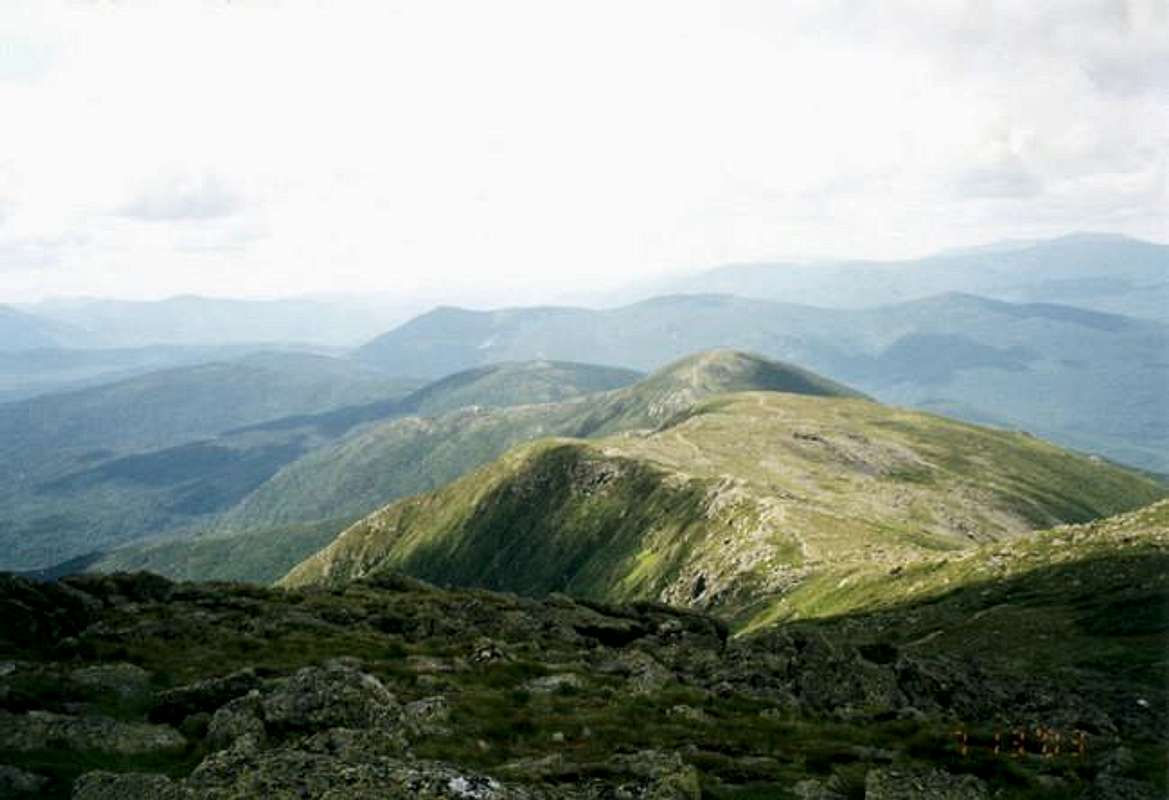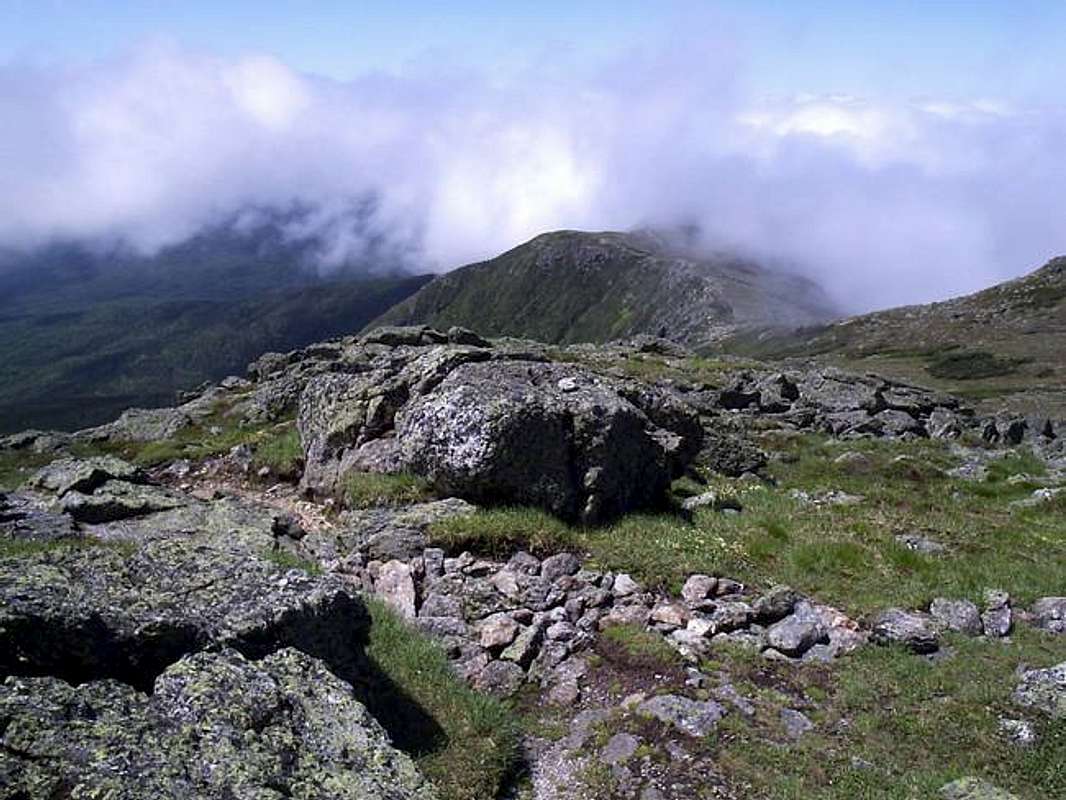-
 34151 Hits
34151 Hits
-
 86.37% Score
86.37% Score
-
 22 Votes
22 Votes
|
|
Mountain/Rock |
|---|---|
|
|
44.24900°N / 71.331°W |
|
|
5001 ft / 1524 m |
|
|
Overview
Mount Franklin is another one of those "unofficial" peaks within the Presidential Range . It is officially not counted on the 4000 footer list for peaks in New Hampshire, but is considered a separate peak by name similar to Mount Clay and Little Haystack . Located within the heart of the Southern Presidentials between Mount Eisenhower and Mount Monroe , Mount Franklin's summit area is totally above treeline. It takes the appearance of an knoby shoulder from Mt. Monroe's summit to the northeast.
The feeling one gets from this summit is of almost hanging out over Oakes Gulf. Mt. Franklin is the second highest peak in the Southern Presidentials as it is second in the descending chain from Mount Monroe . Weather here is a considerable factor so do not judge that aspect too lightly. The weather here can turn deadly at anytime as the Presidential Range is famous for its winter storms at all times of the year which sometimes seem to come out of nowhere. Check the weather report before you head out and make sure you have bad weather gear when you do set out.
Mount Franklin is very rarely if ever a lone destination of hikers. From the valleys below it is barely visible, but there is a much bigger difference once you are on the ridge. The most common routes of action to this summit would be on a loop hike via the Ammonoosuc Ravine Trail and the Edmands Path. An out and back hike can be done as well, but is usually only done from the Edmands Path up to the summit of Mount Monroe in which you will cross Mount Franklin.
When it comes to views, Mt. Franklin has plenty along with its other brothers on the windswept ridgeline. To the southwest can be seen the peaks of the Pemigewasset Wilderness including Mts. Lafayette, Lincoln, Liberty, Flume, Garfield, and the Twins (North and South Twin). Beyond is the Kinsman Range. To the south are the peaks of the Sandwich Range. Continuing around to the east is the Carter Range. The next view lines up the high peaks of the White Mountains with Monroe, Washington, Clay, Jefferson, Adams, and Madison.
Getting There
From Boston:Take Interstate 93 north for approximately 1.5-2 hours. Head through Franconia Notch and at the north end take the exit Highway 3 east. Follow this to Twin Mountain. From here take Route 302 towards Crawford Notch. The Presidential Peaks will be looming ahead of you. At Bretton Woods take the road off the left of the highway that crosses the railroad tracks. Follow this to the Mount Clinton Road where you will want turn right for the Edmands Path (follow signs). For the Ammonoosuc Ravine Trail stay straight and the parking lot is on the right, just before you reach the base station.
From Littleton, NH:
Head south on Interstate 93 until you reach the exit for Twin Mountain (Route 302). From here head east on Route 302 to Bretton Woods. At Bretton Woods take the road off the left of the highway that crosses the railroad tracks. Follow this to the Mount Clinton Road where you will want turn right for the Edmands Path (follow signs). For the Ammonoosuc Ravine Trail stay straight and the parking lot is on the right, just before you reach the base station.
Red Tape
There are no permits required to hike in White Mountains National Forest. The only fee you will have to pay is at the trailhead for parking your car. Last time I checked it was three dollars. For wildlife and land conservation purposes just follow the “LEAVE NO TRACE” program and you will be fine. Be a steward of the trail, not a killer.When To Climb
This summit is a possibility in all times of the year, however, unless you're climbing another Presidential peak in the winter this is not a suggested lone destination. This summit is best done from Spring to Fall in a loop hike with other peaks of the Southern Presidentials. Winter time is especially harsh in the Presidentials so only experienced winter climbers should make summit attempts during this time period.Camping
Here are the camping rules and restrictions for the White Mountains National Forest according to the AMC's White Mountains Guide:1) No camping is permitted above treeline except in winter. For winter camping there must be at least two feet of snow on the ground. No camping on a frozen body of water.
2) No camping is allowed within a quarter mile of any trailhead, road, picnic area, overnight hut, cabin, shelter, or tentsite.
3) No camping is permitted within 200 feet of trails.
If the area you are looking to camp in does not qualify for any of the areas mentioned you should be good for camping. Just make sure you pack it in and pack it out to preserve the White Mountains National Forest for the future.
Mountain Conditions

Weather conditions in the Presidential Range are extremely harsh. This are in the White Mountains arguably has the worst weather on earth. Make sure you take all the precautions necessary to have a safe trip in this range. Check the weather multiple times before you leave. If the weather appears threatening, do not stick around to find out. Get off the mountain! The mountains will be there tomorrow and in the future, but you will not if you take the wrong chances.
Here are some of records found on nearby Mt. Washington!
Avg. Summer Temp. = 55F
Avg. Winter Temp. = 15F
Highest Recorded Temp. = 72F
Lowest Recorded Temp. = -46F
Avg. Summer Wind Speed = 26mph
Avg. Winter Wind Speed = 44mph
Highest Recorded Wind Speed = 231mph(world record)
Highest Total Snowfall in 24hr Period = 49.3 inches
For current and up-to-date weather conditions click on the link below:
weather.com
Also visit mountwashington.org for up-to-date and current weather conditions on the summit of New England's highest peak.






